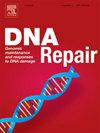Discovery of KPT-6566 as STAG1/2 Inhibitor sensitizing PARP and NHEJ Inhibitors to suppress tumor cells growth in vitro
IF 2.7
3区 生物学
Q2 GENETICS & HEREDITY
引用次数: 0
Abstract
Stromal antigen 1 and 2 (STAG1 and STAG2) are two mutually exclusive components of the cohesin complex that is crucial for centromeric and telomeric cohesion. Beyond its structural role, STAG2 also plays a pivotal role in homologous recombination (HR) repair and has emerged as a promising therapeutic target in cancer treatment. Here, we employed a fluorescence polarization (FP)-based high-throughput screening and identified KPT-6566 as a dual inhibitor of STAG1 and STAG2. Biochemical and biophysical analyses demonstrated that KPT-6566 directly binds to STAG1 and STAG2, disrupting their interactions with SCC1 and double-stranded DNA. A metaphase chromosome spread assay showed that KPT-6566 causes premature chromosome separation and induces chromosome damages in HeLa cells. Furthermore, KPT-6566 also impairs DNA damage repair, leading to the accumulation of double-strand breaks and cell apoptosis. Finally, KPT-6566 can sensitize HeLa and HepG2 cells to PARP inhibitor Olaparib and the NHEJ inhibitor UMI-77, exhibiting a synergistic effect in suppressing cell proliferation. Our findings highlight the potential of STAG1/2 as promising therapeutic targets in cancer treatment, particularly when they are targeted in combination with other DNA damage response inhibitors.
发现 KPT-6566 可作为 STAG1/2 抑制剂,使 PARP 和 NHEJ 抑制剂敏感,从而抑制肿瘤细胞在体外的生长。
基质抗原 1 和 2(STAG1 和 STAG2)是凝聚素复合物的两个互斥成分,对中心粒和端粒的凝聚至关重要。除了其结构作用外,STAG2 还在同源重组(HR)修复中发挥着关键作用,并已成为癌症治疗中一个很有前景的治疗靶点。在这里,我们采用了基于荧光偏振(FP)的高通量筛选方法,发现 KPT-6566 是 STAG1 和 STAG2 的双重抑制剂。生化和生物物理分析表明,KPT-6566 能直接与 STAG1 和 STAG2 结合,破坏它们与 SCC1 和双链 DNA 的相互作用。转移期染色体扩散试验表明,KPT-6566 会导致 HeLa 细胞中染色体过早分离并诱发染色体损伤。此外,KPT-6566 还会损害 DNA 损伤修复,导致双链断裂积累和细胞凋亡。最后,KPT-6566 能使 HeLa 和 HepG2 细胞对 PARP 抑制剂 Olaparib 和 NHEJ 抑制剂 UMI-77 敏感,在抑制细胞增殖方面表现出协同效应。我们的研究结果凸显了 STAG1/2 作为癌症治疗靶点的潜力,尤其是当它们与其他 DNA 损伤反应抑制剂联合使用时。
本文章由计算机程序翻译,如有差异,请以英文原文为准。
求助全文
约1分钟内获得全文
求助全文
来源期刊

DNA Repair
生物-毒理学
CiteScore
7.60
自引率
5.30%
发文量
91
审稿时长
59 days
期刊介绍:
DNA Repair provides a forum for the comprehensive coverage of DNA repair and cellular responses to DNA damage. The journal publishes original observations on genetic, cellular, biochemical, structural and molecular aspects of DNA repair, mutagenesis, cell cycle regulation, apoptosis and other biological responses in cells exposed to genomic insult, as well as their relationship to human disease.
DNA Repair publishes full-length research articles, brief reports on research, and reviews. The journal welcomes articles describing databases, methods and new technologies supporting research on DNA repair and responses to DNA damage. Letters to the Editor, hot topics and classics in DNA repair, historical reflections, book reviews and meeting reports also will be considered for publication.
 求助内容:
求助内容: 应助结果提醒方式:
应助结果提醒方式:


